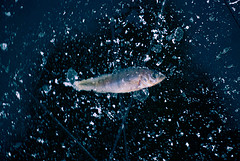Words To Know:
notothenoids: the arctic ice fish
practical application: how organisms adapt through natural selection
superheating: solid is above its melting point but does not actually it to melt at this point
Origins:
Fish in Antarctica have been forced to evolve natural antifreeze proteins to stay alive. These proteins are mainly found in the notothenoid fishes, which are found in freezing temperatures. Arthur DeVries discovered these fish, their ice- binding-proteins and also figured out how they work in the 1960s . The proteins bind to small crystals and also protect cells by binding to their cell membranes. They are anti-freezing proteins that allow fish to survive and adapt to harsh and cold conditions of arctic waters.
Recent Discoveries:
Paul Cziko, among other researchers in the United States and New Zealand, published in The Proceedings of the National Academy of Sciences that these ‘anti freeze’ proteins’ are also ‘anti melting’. Cziko and his team wanted to understand the antifreeze ability and examined if an anti-freeze protein (that was attached to an ice crystal inside the fish) would melt when the temperature rose. Instead, they found that the ice crystals did not melt. Ice above the melting is point is considered superheated. Cziko’s research basically says that even when it is way past its melting point, the ice (that’s latched on to the protein) still stays frozen inside the fish. These ‘anti-freezing’ proteins are also ‘anti-melting’ proteins that cause ice crystals to accumulate in the fish’s body.
The study shows evolution, not practical application, and this is a typical case of ‘evolutionary trade off’. There are difficulties that get solved, but there’s also a price to pay. Cziko’s research has not indicated any unfavorable effect due to the crystals, but the crystals could potentially block up the blood vessels of the fish and provoke an inflammatory reaction.
Personal Statement:
Personally, I really liked the NY Times article. I actually didn’t realize that we had to find additional articles until I re-read the assignment sheet. I found other articles because I was genuinely curious as to how this worked and came about. I was initially attracted to the word ‘protein’ in the article’ title -since it relates to what we are learning in class- but stayed because of the evolutionary aspect. It has always been hard for me to think of evolution as something. It is such a difficult-to-grasp concept since you can’t really see it happening . But, in some way- this made me think that I did see evolution. Instead of making me think of evolution as a concept or theory that I learn at school, it made me think of it as a reality, and as something that actually happens.
Original Article: http://www.nytimes.com/2014/09/23/science/antifreeze-proteins-keep-antarctic-fish-alive-and-icy.html?ref=science&_r=0
Additional Article: http://thewestsidestory.net/2014/09/23/17354/antarctic-fish-anti-freeze-anti-melt-proteins-keeps-freezing/
Additional Article: http://www.scienceworldreport.com/articles/17326/20140923/antarctic-fish-antifreeze-blood-ice-crystals-bodies.htm



camouflage
This is super interesting in that I had no idea there were fish living in the waters of Antarctica. I assumed it was too cold and therefore uninhabitable. I looked up a little more about this topic of anti-melting, and according to http://www.nsf.gov/news/news_summ.jsp?cntn_id=132798, they say the effects of the ice particles staying within the fish are similar to those of asbestos in our brain and lungs. Also, this ice that doesn’t melt is called “superheated”. Thanks again for enlightening me on this interesting fact.